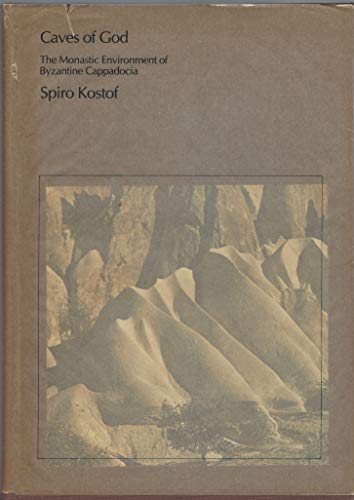Caves of God: The monastic environment of Byzantine Cappadocia - Hardcover

Cappadocia, a province in central Turkey, offers the traveler a startling rockscape whose cones, pleats, and folds conceal hundreds of monasteries and churches carved from the soft, porous "tuff" and used by Christian communities over nearly two millennia for shelter, burial, and sanctuary. This region in the Turkish hinterland is recognized as one of the centers of Byzantine mural painting. However, numerous hermitages, monasteries, and independent chapels dating from the seventh century onward reveal it also as one of the most concentrated areas of Eastern monasticism.This book serves a double purpose: it provides a thorough and lucid introduction to the rockcut churches and monasteries and their painted decorations, while it critically examines current scholarship on the monastic environment of Byzantine Cappadocia--particularly in regard to the architecture, which has been generally neglected by art historians.Scooped out rather than constructed, this anonymous architecture has its own unique appeal. Kostof writes: "The Cappadocian carver-architect was not inhibited... by statics or the nature of materials. His structure stood, a monolith, before he started to work on it. And he could cut into this monolith quickly, effortlessly. It might take a single man about a month to carve out a large room of two to three thousand cubic feet. Loads and thrusts were negligible. One was free to try any structural symbol with little concern for structural safety. Cupolas could bubble from flat ceilings, or be placed over square bays by means of the most cavalier transition elemenis. No shape need be perfect: extemporaneous geometry is everywhere the rule. Wall lines sag, one half of an arch doesn't quite match the other, carefree deviations, here and there, mark the general outline of the building."Following an account of the region, its environmental, political, and religious history, the author discusses in detail the building types and painting programs in the context of their creation--answering such questions as what was the nature of monasticism in Cappadocia, and who were the builders, the artists, their patrons? The author was born and educated in Turkey, and his personal knowledge of the monuments is a convincing factor in his handling of chronological and stylistic uncertainties. Throughout, Kostof's mind's eye never leaves the total environment, observing the inseparability of landscape, buildings, paintings, and the ritual that informs them.
"synopsis" may belong to another edition of this title.
"In Cappadocia, a bleak and relatively barren section of south central Turkey,nature has provided a moonscape environment replenished with a wild and at times bizarre array of rock formation.It was in this remote, forbidding area thatByzantine monks from approximately500 through 1200 A.D. created a strange,unreal world of rock-cut hermitages,monasteries, and churches. Kostof'sstudy is comprehensive. It presents acatalog of the major rock-cut buildingsand then painstakingly examines theirarchitectural styles and the numerousstyles of mural paintings that cover manyof their walls and ceilings... the bookbeautifully conjures up a sense and a feelfor the place, its man-made artifacts, andthe beliefs of the men who lived there.The excellent, very enjoyable text is supplemented by many... black-and-white plates, andrevealing line drawings of plans, elevations, and cross sections." Library Journal
"A haunting book about a... remotearchitectural and topographical marvel.In a lunar, rocky region of centralTurkey, visited by Saint Paul and converted early to Christianity, churches andmonasteries were carved directly intothe soft cliffs. The rockscape itself iseerie: there are photographs of strangelyfolded white hills and free-standingconelike formations eaten away by wind,with residues of harder rock perched ontheir summits like hats. The anonymousarchitecture hollowed out inside theslopes dates from the seventh century; itis fantastically resourceful in its responseto a peculiar environment. In theirchaste, no-nonsense design, MIT's booksare consistently handsome, and this oneis particularly so." Newsweek
"About this title" may belong to another edition of this title.
- PublisherMIT Press
- Publication date1972
- ISBN 10 0262110423
- ISBN 13 9780262110426
- BindingHardcover
- Edition number1
- Number of pages296
- Rating
Buy New
Learn more about this copy
Shipping:
US$ 5.41
Within U.S.A.
Top Search Results from the AbeBooks Marketplace
CAVES OF GOD: THE MONASTIC ENVIR
Book Description Condition: New. New. In shrink wrap. Looks like an interesting title! 1.73. Seller Inventory # Q-0262110423

